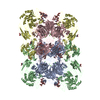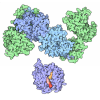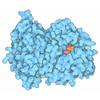+ Open data
Open data
- Basic information
Basic information
| Entry | Database: EMDB / ID: EMD-9133 | |||||||||
|---|---|---|---|---|---|---|---|---|---|---|
| Title | Human TRPM2 ion channel in an ADPR-bound state | |||||||||
 Map data Map data | ||||||||||
 Sample Sample |
| |||||||||
 Keywords Keywords | Channel / MEMBRANE PROTEIN / TRPM2 / TRP / ADPR / ADP-ribose / NUDT9H / NUDT9 / calcium / ion channel | |||||||||
| Function / homology |  Function and homology information Function and homology informationmono-ADP-D-ribose binding / manganese ion transmembrane transporter activity / ligand-gated calcium channel activity / dendritic cell differentiation / zinc ion transmembrane transport / response to purine-containing compound / cellular response to temperature stimulus / regulation of filopodium assembly / response to hydroperoxide / dendritic cell chemotaxis ...mono-ADP-D-ribose binding / manganese ion transmembrane transporter activity / ligand-gated calcium channel activity / dendritic cell differentiation / zinc ion transmembrane transport / response to purine-containing compound / cellular response to temperature stimulus / regulation of filopodium assembly / response to hydroperoxide / dendritic cell chemotaxis / calcium ion transmembrane import into cytosol / TRP channels / temperature homeostasis / sodium channel activity / intracellularly gated calcium channel activity / calcium ion import across plasma membrane / tertiary granule membrane / ficolin-1-rich granule membrane / monoatomic cation channel activity / specific granule membrane / release of sequestered calcium ion into cytosol / cellular response to calcium ion / cytoplasmic vesicle membrane / cell projection / regulation of actin cytoskeleton organization / calcium ion transmembrane transport / calcium channel activity / cellular response to hydrogen peroxide / calcium ion transport / response to heat / perikaryon / protein homotetramerization / lysosome / lysosomal membrane / calcium ion binding / Neutrophil degranulation / plasma membrane Similarity search - Function | |||||||||
| Biological species |  Homo sapiens (human) Homo sapiens (human) | |||||||||
| Method | single particle reconstruction / cryo EM / Resolution: 6.1 Å | |||||||||
 Authors Authors | Wang L / Fu TM | |||||||||
 Citation Citation |  Journal: Science / Year: 2018 Journal: Science / Year: 2018Title: Structures and gating mechanism of human TRPM2. Authors: Longfei Wang / Tian-Min Fu / Yiming Zhou / Shiyu Xia / Anna Greka / Hao Wu /  Abstract: Transient receptor potential (TRP) melastatin 2 (TRPM2) is a cation channel associated with numerous diseases. It has a C-terminal NUDT9 homology (NUDT9H) domain responsible for binding adenosine ...Transient receptor potential (TRP) melastatin 2 (TRPM2) is a cation channel associated with numerous diseases. It has a C-terminal NUDT9 homology (NUDT9H) domain responsible for binding adenosine diphosphate (ADP)-ribose (ADPR), and both ADPR and calcium (Ca) are required for TRPM2 activation. Here we report cryo-electron microscopy structures of human TRPM2 alone, with ADPR, and with ADPR and Ca NUDT9H forms both intra- and intersubunit interactions with the N-terminal TRPM homology region (MHR1/2/3) in the apo state but undergoes conformational changes upon ADPR binding, resulting in rotation of MHR1/2 and disruption of the intersubunit interaction. The binding of Ca further engages transmembrane helices and the conserved TRP helix to cause conformational changes at the MHR arm and the lower gating pore to potentiate channel opening. These findings explain the molecular mechanism of concerted TRPM2 gating by ADPR and Ca and provide insights into the gating mechanism of other TRP channels. | |||||||||
| History |
|
- Structure visualization
Structure visualization
| Movie |
 Movie viewer Movie viewer |
|---|---|
| Structure viewer | EM map:  SurfView SurfView Molmil Molmil Jmol/JSmol Jmol/JSmol |
| Supplemental images |
- Downloads & links
Downloads & links
-EMDB archive
| Map data |  emd_9133.map.gz emd_9133.map.gz | 95.7 MB |  EMDB map data format EMDB map data format | |
|---|---|---|---|---|
| Header (meta data) |  emd-9133-v30.xml emd-9133-v30.xml emd-9133.xml emd-9133.xml | 10.4 KB 10.4 KB | Display Display |  EMDB header EMDB header |
| Images |  emd_9133.png emd_9133.png | 65.1 KB | ||
| Filedesc metadata |  emd-9133.cif.gz emd-9133.cif.gz | 6 KB | ||
| Archive directory |  http://ftp.pdbj.org/pub/emdb/structures/EMD-9133 http://ftp.pdbj.org/pub/emdb/structures/EMD-9133 ftp://ftp.pdbj.org/pub/emdb/structures/EMD-9133 ftp://ftp.pdbj.org/pub/emdb/structures/EMD-9133 | HTTPS FTP |
-Validation report
| Summary document |  emd_9133_validation.pdf.gz emd_9133_validation.pdf.gz | 559 KB | Display |  EMDB validaton report EMDB validaton report |
|---|---|---|---|---|
| Full document |  emd_9133_full_validation.pdf.gz emd_9133_full_validation.pdf.gz | 558.5 KB | Display | |
| Data in XML |  emd_9133_validation.xml.gz emd_9133_validation.xml.gz | 6.5 KB | Display | |
| Data in CIF |  emd_9133_validation.cif.gz emd_9133_validation.cif.gz | 7.5 KB | Display | |
| Arichive directory |  https://ftp.pdbj.org/pub/emdb/validation_reports/EMD-9133 https://ftp.pdbj.org/pub/emdb/validation_reports/EMD-9133 ftp://ftp.pdbj.org/pub/emdb/validation_reports/EMD-9133 ftp://ftp.pdbj.org/pub/emdb/validation_reports/EMD-9133 | HTTPS FTP |
-Related structure data
| Related structure data |  6mizMC  9132C  9134C  6mixC  6mj2C C: citing same article ( M: atomic model generated by this map |
|---|---|
| Similar structure data |
- Links
Links
| EMDB pages |  EMDB (EBI/PDBe) / EMDB (EBI/PDBe) /  EMDataResource EMDataResource |
|---|---|
| Related items in Molecule of the Month |
- Map
Map
| File |  Download / File: emd_9133.map.gz / Format: CCP4 / Size: 103 MB / Type: IMAGE STORED AS FLOATING POINT NUMBER (4 BYTES) Download / File: emd_9133.map.gz / Format: CCP4 / Size: 103 MB / Type: IMAGE STORED AS FLOATING POINT NUMBER (4 BYTES) | ||||||||||||||||||||||||||||||||||||||||||||||||||||||||||||||||||||
|---|---|---|---|---|---|---|---|---|---|---|---|---|---|---|---|---|---|---|---|---|---|---|---|---|---|---|---|---|---|---|---|---|---|---|---|---|---|---|---|---|---|---|---|---|---|---|---|---|---|---|---|---|---|---|---|---|---|---|---|---|---|---|---|---|---|---|---|---|---|
| Projections & slices | Image control
Images are generated by Spider. | ||||||||||||||||||||||||||||||||||||||||||||||||||||||||||||||||||||
| Voxel size | X=Y=Z: 1.07 Å | ||||||||||||||||||||||||||||||||||||||||||||||||||||||||||||||||||||
| Density |
| ||||||||||||||||||||||||||||||||||||||||||||||||||||||||||||||||||||
| Symmetry | Space group: 1 | ||||||||||||||||||||||||||||||||||||||||||||||||||||||||||||||||||||
| Details | EMDB XML:
CCP4 map header:
| ||||||||||||||||||||||||||||||||||||||||||||||||||||||||||||||||||||
-Supplemental data
- Sample components
Sample components
-Entire : Human TRPM2 ion channel
| Entire | Name: Human TRPM2 ion channel |
|---|---|
| Components |
|
-Supramolecule #1: Human TRPM2 ion channel
| Supramolecule | Name: Human TRPM2 ion channel / type: complex / ID: 1 / Parent: 0 / Macromolecule list: all |
|---|---|
| Source (natural) | Organism:  Homo sapiens (human) Homo sapiens (human) |
-Macromolecule #1: Transient receptor potential cation channel subfamily M member 2
| Macromolecule | Name: Transient receptor potential cation channel subfamily M member 2 type: protein_or_peptide / ID: 1 / Number of copies: 4 / Enantiomer: LEVO |
|---|---|
| Source (natural) | Organism:  Homo sapiens (human) Homo sapiens (human) |
| Molecular weight | Theoretical: 171.416188 KDa |
| Recombinant expression | Organism:  Homo sapiens (human) Homo sapiens (human) |
| Sequence | String: MEPSALRKAG SEQEEGFEGL PRRVTDLGMV SNLRRSNSSL FKSWRLQCPF GNNDKQESLS SWIPENIKKK ECVYFVESSK LSDAGKVVC QCGYTHEQHL EEATKPHTFQ GTQWDPKKHV QEMPTDAFGD IVFTGLSQKV KKYVRVSQDT PSSVIYHLMT Q HWGLDVPN ...String: MEPSALRKAG SEQEEGFEGL PRRVTDLGMV SNLRRSNSSL FKSWRLQCPF GNNDKQESLS SWIPENIKKK ECVYFVESSK LSDAGKVVC QCGYTHEQHL EEATKPHTFQ GTQWDPKKHV QEMPTDAFGD IVFTGLSQKV KKYVRVSQDT PSSVIYHLMT Q HWGLDVPN LLISVTGGAK NFNMKPRLKS IFRRGLVKVA QTTGAWIITG GSHTGVMKQV GEAVRDFSLS SSYKEGELIT IG VATWGTV HRREGLIHPT GSFPAEYILD EDGQGNLTCL DSNHSHFILV DDGTHGQYGV EIPLRTRLEK FISEQTKERG GVA IKIPIV CVVLEGGPGT LHTIDNATTN GTPCVVVEGS GRVADVIAQV ANLPVSDITI SLIQQKLSVF FQEMFETFTE SRIV EWTKK IQDIVRRRQL LTVFREGKDG QQDVDVAILQ ALLKASRSQD HFGHENWDHQ LKLAVAWNRV DIARSEIFMD EWQWK PSDL HPTMTAALIS NKPEFVKLFL ENGVQLKEFV TWDTLLYLYE NLDPSCLFHS KLQKVLVEDP ERPACAPAAP RLQMHH VAQ VLRELLGDFT QPLYPRPRHN DRLRLLLPVP HVKLNVQGVS LRSLYKRSSG HVTFTMDPIR DLLIWAIVQN RRELAGI IW AQSQDCIAAA LACSKILKEL SKEEEDTDSS EEMLALAEEY EHRAIGVFTE CYRKDEERAQ KLLTRVSEAW GKTTCLQL A LEAKDMKFVS HGGIQAFLTK VWWGQLSVDN GLWRVTLCML AFPLLLTGLI SFREKRLQDV GTPAARARAF FTAPVVVFH LNILSYFAFL CLFAYVLMVD FQPVPSWCEC AIYLWLFSLV CEEMRQLFYD PDECGLMKKA ALYFSDFWNK LDVGAILLFV AGLTCRLIP ATLYPGRVIL SLDFILFCLR LMHIFTISKT LGPKIIIVKR MMKDVFFFLF LLAVWVVSFG VAKQAILIHN E RRVDWLFR GAVYHSYLTI FGQIPGYIDG VNFNPEHCSP NGTDPYKPKC PESDATQQRP AFPEWLTVLL LCLYLLFTNI LL LNLLIAM FNYTFQQVQE HTDQIWKFQR HDLIEEYHGR PAAPPPFILL SHLQLFIKRV VLKTPAKRHK QLKNKLEKNE EAA LLSWEI YLKENYLQNR QFQQKQRPEQ KIEDISNKVD AMVDLLDLDP LKRSGSMEQR LASLEEQVAQ TAQALHWIVR TLRA SGFSS EADVPTLASQ KAAEEPDAEP GGRKKTEEPG DSYHVNARHL LYPNCPVTRF PVPNEKVPWE TEFLIYDPPF YTAER KDAA AMDPMGDTLE PLSTIQYNVV DGLRDRRSFH GPYTVQAGLP LNPMGRTGLR GRGSLSCFGP NHTLYPMVTR WRRNED GAI CRKSIKKMLE VLVVKLPLSE HWALPGGSRE PGEMLPRKLK RILRQEHWPS FENLLKCGME VYKGYMDDPR NTDNAWI ET VAVSVHFQDQ NDVELNRLNS NLHACDSGAS IRWQVVDRRI PLYANHKTLL QKAAAEFGAH Y UniProtKB: Transient receptor potential cation channel subfamily M member 2 |
-Experimental details
-Structure determination
| Method | cryo EM |
|---|---|
 Processing Processing | single particle reconstruction |
| Aggregation state | particle |
- Sample preparation
Sample preparation
| Buffer | pH: 7.4 |
|---|---|
| Grid | Details: unspecified |
| Vitrification | Cryogen name: ETHANE |
- Electron microscopy
Electron microscopy
| Microscope | FEI TITAN KRIOS |
|---|---|
| Image recording | Film or detector model: GATAN K2 SUMMIT (4k x 4k) / Average electron dose: 70.072 e/Å2 |
| Electron beam | Acceleration voltage: 300 kV / Electron source:  FIELD EMISSION GUN FIELD EMISSION GUN |
| Electron optics | Illumination mode: FLOOD BEAM / Imaging mode: BRIGHT FIELD |
| Experimental equipment |  Model: Titan Krios / Image courtesy: FEI Company |
- Image processing
Image processing
| Startup model | Type of model: PDB ENTRY / Details: 6MIX |
|---|---|
| Final reconstruction | Resolution.type: BY AUTHOR / Resolution: 6.1 Å / Resolution method: FSC 0.143 CUT-OFF / Number images used: 49383 |
| Initial angle assignment | Type: MAXIMUM LIKELIHOOD / Details: Relion 2.0 |
| Final angle assignment | Type: RANDOM ASSIGNMENT / Details: cisTEM |
 Movie
Movie Controller
Controller













 X (Sec.)
X (Sec.) Y (Row.)
Y (Row.) Z (Col.)
Z (Col.)





















